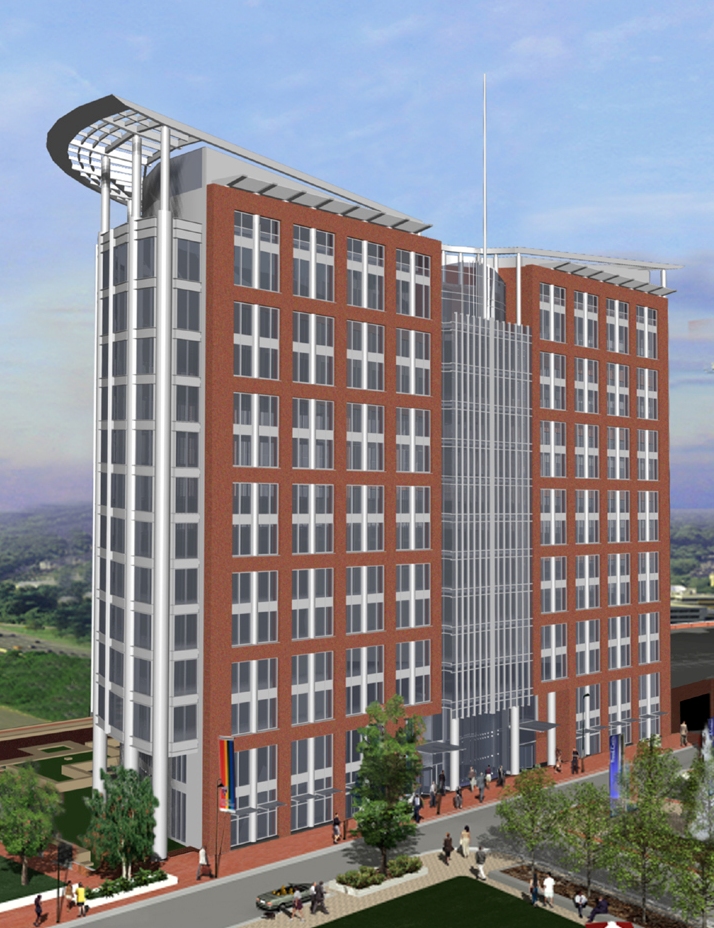Building Statistics
General Building Data
Building name: Towers Crescent Building F.
Location and site: Chantilly, VA, near the intersection of Leesburg Pike Rte. 7 and the 495 Capital Beltway.
Occupant: Speculative office building. The project is owned by the Quadrangle Development Corporation, which presumably will rent out the office space to various tenants.
Occupancy or function types: Offices on top of parking structure.
Size: 339,063 sq. ft.
Stories above grade: 13
Primary project team:
Owner: Quadrangle Development Corporation
Architect: SmithGroup
Structural Engineer: Original Desingn: KCE; Redesign: SK&A
MEP Engineers: GHT Limited
Civil Engineer: VIKA
Landscape: Sasaki Associates
Specifications: Heller and Metzger
Construction Management: Hensel Phelps
Dates of construction: Construction begins January 2007. Estimated duration is 30 months.
Estimated Cost : $80,950,000
Project delivery method: Design-build.
Architecture
Architecture: The Towers Crescent building F is a semicircular tower sitting on several subterranean parking levels. In the center of each floor of the tower there is a core area containing elevators, bathrooms, stairways, electrical and mechanical rooms, etc. The rest of the floor area is open except for the structural columns; finishes are to be provided by the tenant. In external appearance the tower is very similar to Penn State’s HUB-Robeson Center, employing a mixture of glass, stainless steel and aluminum, and brick veneer. Exterior concrete structural columns are encased in aluminum. A large area of glass in aluminum framing runs up the center of the flat, front face of the tower; a painted steel spire projects from this surface above the building. On top of the tower there is a large architectural ornament which resembles a metal fan spread out over the building.
Major national model codes: IBC 2000, NFCP 1996, IMC 2000, IPC 2000, 1999 NEC
Zoning: The building site is in a C-4 Zone. Setbacks must be 40 ft. minimum in the front and 25 ft. minimum in the back, and the building must be no higher than 200 ft. above the average site grade.
Building envelope: The roofing system is a concrete slab with a waterproofing membrane, a separation sheet, rigid insulation, and ballast. The wall systems are varied around the surface of the building. The curved face (North, East, and West) consists of cylindrical concrete columns encased in aluminum, and insulated, tempered vision glass hung in unitized aluminum framing attached to the structural slab at each floor. The flat, south wall has a large amount of brick veneer sitting on shelf angles on every other floor of the structural slab, as well as glass in aluminum framing.
Primary Engineering Systems
Electrical: The main switchboard is in the sub-basement. Two 4000A, 470V, 3-phase, 4-wire busways carry the current up the length of the building, with (2) 400 Amp fusible taps fused at 400 Amps splitting some of the current to each floor.
Lighting: The building contains a 120V and 265V system of emergency lights, and a 120V and 277V system of general and architectural lights. Primary lamp types are fluorescent and HID. Strips of F32-T8 fluorescent lights provide most of the general lighting.
Mechanical: There are two 26,300 CFM rooftop mechanical units, each serving one wing of the building. These supply air to the whole tower through a system of ducts and 150-900 CFM VAV boxes. There is a separate, smaller air handling unit for the elevators.
Structural: The building utilizes a foundation system of 80T 16" diameter auger cast piles. The frame is a mostly regular grid of concrete columns (typically 24" x 24" or 12" x 36") spaced 30' x 30', as well as a radial series of 36" diameter columns along the semicircular face of the building. The floors are typically 9" flat concrete slab with drop panels and drop bands, reinforced by a bottom matt of #5 rebar at 12" O.C. and additional reinforcement as needed. Concrete shear walls and moment frames provide lateral resistance. The architectural ornament at the top of the building is composed primarily of structural steel tubing.
Additional Engineering and Engineering Support Systems
Fire Protection: The office building is construction type 1B, while the parking structure is construction type 2A. All structural assemblies meet the IBC 2000 fire rating requirements. The exit access corridor enclosure wall is a fire separation assembly rated at 1 hour. There are two stair pressurization systems to protect people escaping from a fire, and the building has an emergency lighting system, a sprinkler system, and fire alarm pull stations.
Transportation: Six elevators and two staircases run up the length of the tower. One of those staircases continues down into the parking levels. Three additional elevators also connect the parking levels to the first floor/plaza of the tower, where the six elevators which run the length of the tower begin.
Telecommunications: There is a telephone room on every floor of the tower within its structural core.
